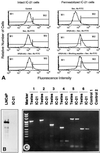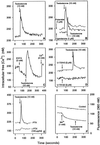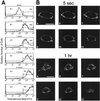Testosterone signaling through internalizable surface receptors in androgen receptor-free macrophages
- PMID: 10512854
- PMCID: PMC25566
- DOI: 10.1091/mbc.10.10.3113
Testosterone signaling through internalizable surface receptors in androgen receptor-free macrophages
Abstract
Testosterone acts on cells through intracellular transcription-regulating androgen receptors (ARs). Here, we show that mouse IC-21 macrophages lack the classical AR yet exhibit specific nongenomic responses to testosterone. These manifest themselves as testosterone-induced rapid increase in intracellular free [Ca(2+)], which is due to release of Ca(2+) from intracellular Ca(2+) stores. This Ca(2+) mobilization is also inducible by plasma membrane-impermeable testosterone-BSA. It is not affected by the AR blockers cyproterone and flutamide, whereas it is completely inhibited by the phospholipase C inhibitor U-73122 and pertussis toxin. Binding sites for testosterone are detectable on the surface of intact IC-21 cells, which become selectively internalized independent on caveolae and clathrin-coated vesicles upon agonist stimulation. Internalization is dependent on temperature, ATP, cytoskeletal elements, phospholipase C, and G-proteins. Collectively, our data provide evidence for the existence of G-protein-coupled, agonist-sequestrable receptors for testosterone in plasma membranes, which initiate a transcription-independent signaling pathway of testosterone.
Figures









References
-
- Beato M. Gene regulation by steroid hormones. Cell. 1989;56:335–344. - PubMed
-
- Benten WPM, Lieberherr M, Giese G, Wrehlke C, Stamm O, Sekeris CE, Mossmann H, Wunderlich F. Functional testosterone receptors in plasma membranes of T cells. FASEB J. 1999;13:123–133. - PubMed
-
- Benten WPM, Lieberherr M, Giese G, Wunderlich F. Estradiol binding to cell surface raises cytosolic free calcium in T cells. FEBS Lett. 1998;422:349–353. - PubMed
-
- Benten WPM, Lieberherr M, Sekeris CE, Wunderlich F. Testosterone induced Ca2+ influx via nongenomic surface receptors in activated T cells. FEBS Lett. 1997;407:211–214. - PubMed
MeSH terms
Substances
LinkOut - more resources
Full Text Sources
Other Literature Sources
Research Materials
Miscellaneous

